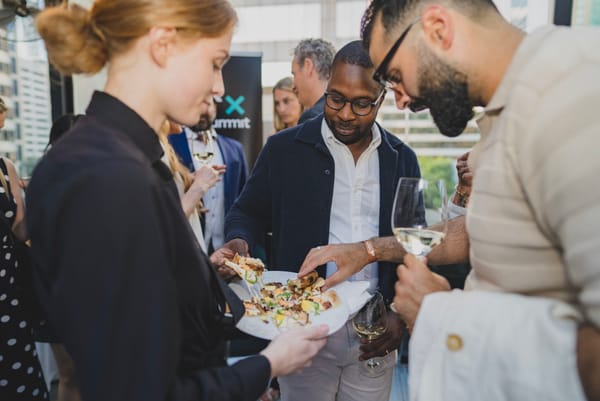Five Vancouver tech founders on fundraising
VC insights, but from entrepreneurs, not VCs.

Hey, it's William. Welcome to (or back to) my notebook – my thoughts, my latest writing, articles worth reading from around the web, and other recommendations.
VC insights, but from entrepreneurs, not VCs
Last week, Dyne CEO Arnav Mishra told a room full of founders that he was travelling to San Francisco to meet a bunch of investors. But he said he’d only take one meeting. So what did he mean? In an unusual move, Mishra explained that he invited six different VCs to the same room at the same time. “I know it’s unconventional,” he admitted. An audience member responded, “Very.” I thought: “Absolutely.” Mishra had his reasons, though. And now, I’m just dying to hear how it all transpired. (I'll report back with anything I learn.)
Mishra was on a panel of entrepreneurs who shared insights from their experiences fundraising. Yes, face-to-meetings, came up. But this group had more to say about the things you should know before the chequewriters are in view. From a 90-minute audience Q&A, you can find seven noteworthy remarks below, edited for clarity.
Arnav Mishra, CEO of Dyne, on what you are actually committing to when you decide you’re building a venture-backed business
There are two schools of thought when it comes to scaling a business. I grew up in India, and in India, venture capital is not as big as here. Businesses are built as if you're building a mansion, you have to lay the groundwork work on it for a couple of years, maybe five, six years. And then maybe you will take some debt financing and scale your business. Traditionally, ownership is 100% with the founder or his family.
Then, I came to Canada, I saw a completely different game. I saw many, many of my peers, including young founders going into this race of scaling valuations. And it's like building a skyscraper, you're no longer building a mansion for your family. You're building a skyscraper, and you’re raising the valuation through different rounds, and everybody on the cap table has a condo in it, which means that what you're doing here is you're creating value.”
Kristine Steuart, former CEO of Allocadia and EIR at iNovia, says that with the tools available now, it’s easier for founders to build an MVP and get traction before raising capital – and more should do it
I think it’s a lot easier to build a product to MVP now and get revenue and traction. It's going to be harder now to raise on an idea; it's still going to happen like if it's something so clearly innovative or really down a thesis or if you're a proven founder, then you will get money. But it’s much harder. There was a lot more of that happening before. But now, just go get your first five to 10 customers – this is what I always say to people – just go get your first customers, do the minimum product possible, go bring revenue in. Good times or bad times in an investor market, that is always going to serve you well. That’s the easiest way to have control over your own story and path and destiny to actually be able to grow a company.
James Clift, founder of Durable, argues what investors want from you really depends on a mix of factors
I think if you're trying to benchmark it, then that's the wrong question. It's like some convergence of team, capital, category or momentum. Timing your fundraising is also really important. So if you doubled last month in your ARR of $200K versus if you grew 5% last month and your ARR is $1 million like all of that goes into these variables. VCs want momentum, and they want timing and what they’re asking is not, ‘Is this going to be a million-dollar business next year?’ It’s ‘Is this going to be like a $100 million business in three years?’ So either raise with no numbers – or some number that has a graph that looks like this [draws air hockey stick].
Steuart believes what investors want varies by stage, but three core metrics (typically) do matter
Every stage is different, but two core metrics people look at today are your growth rate of your total ARR and your net retention. Because net retention is a proxy that you know the value that you're delivering to your customers. VCs will often say they won't be big, big experts in your space. But net retention is a way to prove that your software is delivering value. And then today, of course, an added one is, you know, not profitability per se at very early stage, but at least some sort of model that shows that you're going to grow in a cash-efficient way.
Mehrsa Raeiszadeh, co-founder of Mintlist, reminds us that it’s lonely out there and hard to find balance
The founder's job is a really lonely job. And it's for real, like, if you've read the book, The Hard Things About Hard Things. That was better than any therapy I had. I cried my eyes out. And I felt connected to this group of virtual founders who had also read the book. If you're a founder, please read it. And so as far as balance goes, I personally failed at building balance when I built Mintlist, and I had investors telling me, ‘Mehrsa, you're working too hard, delegate tasks. This is a long marathon, and we're here to support you.’ I got a lot of support, I have a fantastic support system, but the thing is that you have to actually listen to them. So whatever works for you, figure out the balance, and stick to it. Because it will burn you out. And you run out of fuel when you need it the most.
Daniel Shalinsky, CEO of Withe, on the real work involved in fundraising – and how to be strategic
Ignore the headlines, it is not sexy. Fundraising is 100% a full-time job. And it's a full-time job prepping to fundraise. We can all tell our own stories. But it all depends on what kind of round you're raising, how much you're raising, because to kind of think about it like drafting a team, if you're raising $200,000, you may not need that many people. You may have access to those people; if you’re raising a million dollars, you're going to want maybe a more formal fund to join as part of that.
In Canada, if you have 50 individual shareholders you basically have the same requirements to report on like Bell or Rogers. So you don't necessarily want to have like 100 angel investors join the round. So I think it's a lot about figuring out how much you want to raise and why; what's gonna get you to that next stage.
Who are you drafting, for lack of a better term, on that cap table? On a million-dollar raise, maybe you want one lead, a follow on and a couple of angels, whereas you know, like I said, on a $200,000 raise, maybe it's just a couple of angels. And so as you think about the composition of your round, who you reach out to, what their thesis is, why you're raising, what you're raising – actually really align with them.
All of the work comes before the fundraise itself so that your days when you're ready to go out and accept cheques are just meeting people. Because if you have to then figure out who you're meeting next week, while you're fundraising, you're never going to get the job done.
Raeiszadeh on the one thing she believes really matters when it comes down to investors
For me, raising capital all comes down to one word, and that is: relationship. And for us, it was easier, I think, because we built the relationship months in advance. And even if I'm not raising, and I'll meet someone that I feel like what you said, it's the right person that can provide the right resources for us to in the next stage of growth; we’ll build the relationships and then we have a monthly update that goes out to all these people. And sometimes I just booked a quarterly or monthly 15 minutes. And they know me, they know how we work. They’re completely up to date. So if the market crashes, anything happens in the market. They've been with us every step of the way. So they know why we are where we are.
My stuff
Speaking of VC... next week I'll be sharing my updated Vancouver VC list for free. It features 50 Vancouver venture capital firms and funds, as well as the key people you need to know at them. To access it, make sure you're subscribed.
ICYMI
- 6 New Year's resolutions for Vancouver tech
- Be bullish on these 6 early-stage startups
- 11 (rough) notes on the state of Vancouver tech
Below is a smaller links section than usual since the above section was much longer than usual.
Semi-local things
Big Tech Spaces
Saje Software, LayerZero, Huawei, and Take Two Interactive have all leased (or sub-leased) significant amounts of office space. What does it mean? Nothing. It doesn't mean anything. The WFH-RTW conversation is over. →
Elsewhere in Canada
Panache Ventures partner Scott Loong has put in writing why he thinks generative AI will make the VC power law obsolete. Note: Loong works at a sector-agnostic, pre-seed VC firm that needs the power law to be true! →
Not tech
"Why Feminism Is Useless Unless the Feature-Length Toy Commercial Wins Every Single Oscar." →
Last year, the Washington Post lost $100M. →
The work required to have an opinion. →
Storefront
Venture capital crisis
I have a discount code for The End Of VC As Founders Know It?, an event featuring executives from Coho Growth, Fort Capital, Pender Ventures, Pocketed, and Later.com. It's on February 13 at entrepreneurship@UBC (Robson Square). The code is nevvco →
Innovate West 2024 (April 16-17)
Use code WJ20 for 20% off your ticket to Innovate West. →



